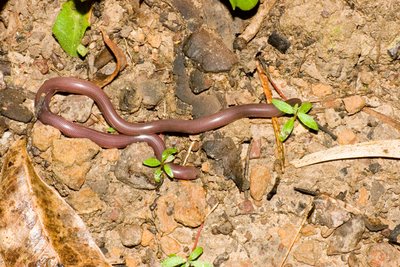 Found a couple of these cool animals on a field trip recently. No, it's not an earthworm, it's actually a young Blackish Blind Snake (Ramphotyphlops nigrescens). I was reminded of the following great story concerning these beasts.
Found a couple of these cool animals on a field trip recently. No, it's not an earthworm, it's actually a young Blackish Blind Snake (Ramphotyphlops nigrescens). I was reminded of the following great story concerning these beasts.They're a highly specialised snake species - while we occasionally get them at the surface at night, a large proportion of a blind snake's life is spent underground (and hence the reduction of the eyes to small pigment spots). And the diet of these creatures? Ants - specifically they get into the galleries and feast on the larvae and pupae. Obviously ants aren't always the most obliging of creatures and this may explain the smooth surface of the blind snake that offers no purchase for a set of angry ant mandibles.
As it turns out, at least one of the way these guys find their food is by following the scent trails of worker ants! Even trails a week old are still followed. When one encounters an ant trail, it stops, tongue flicks the trail before following it, tongue-flicking as it goes. Eventually it hopefully ends up at the ant nest where it feasts on the developing young.
But the story doesn't end there.
There's a species of snake called the Bandy Bandy (Vermicella annulata) which feeds pretty much exclusively on blind snakes. It's a beautiful creature (though I've not seen one), boldly annulated in black and white. Offer it a scent trail of a blind snake and lo and behold it's transfixed; progressing along the trail while flicking its tongue. Trails of non-prey species are ignored.
So if you ever see a bandy bandy or a blind snake making its way along the ground with a determined look in its eye, think about the way in which both these snakes are specialised to use their olfactory environment to track down their hard-to-find prey.
References:
Greenlees, M., J. K. Webb, and R. Shine. 2005. Led by the blind: bandy bandy snakes Vermicella annulata (Elapidae) follow blindsnake chemical trails. Copeia 2005:184-187.
Webb, J. K., and R. Shine. 1992. To find an ant: trail-following behaviour in the eastern Australian blindsnake Rhamphotyphlops nigrescens. Animal Behaviour 43:941-948.



4 comments:
You saw a blind snake, you lucky thing!
I've seen a handful in my time as a frogger; often on roads on moist nights. The one photographed though was just a bubby, earthworm sized, and I found it on the gravelly ground in a quarry.
I've found another one under a sheet of corro where some Polyrhachis ants had a nest. The other one I've seen was floating (still alive) in a pool in the top end!
...only a matter of time till I see a bandy bandy!
There's some fascinating observations and info there!
I have been lucky enough to see a bandy bandy while fossicking for thunder-eggs in NW NSW some years ago. Unfortunately it was at a time when I knew very little of the intricacies of nature and it frightened the bejezus out of me.
I have also seen blind snakes (like in your picture) while renovating my yard, but I actually thought they were legless lizards.
Thanks for sharing all this.
hv
"blind snake" ......... "determined look in its eye"
hmmmmm
Post a Comment